*Positioning
Positioning of Netflix: market leader in a fast, tumultuous market.
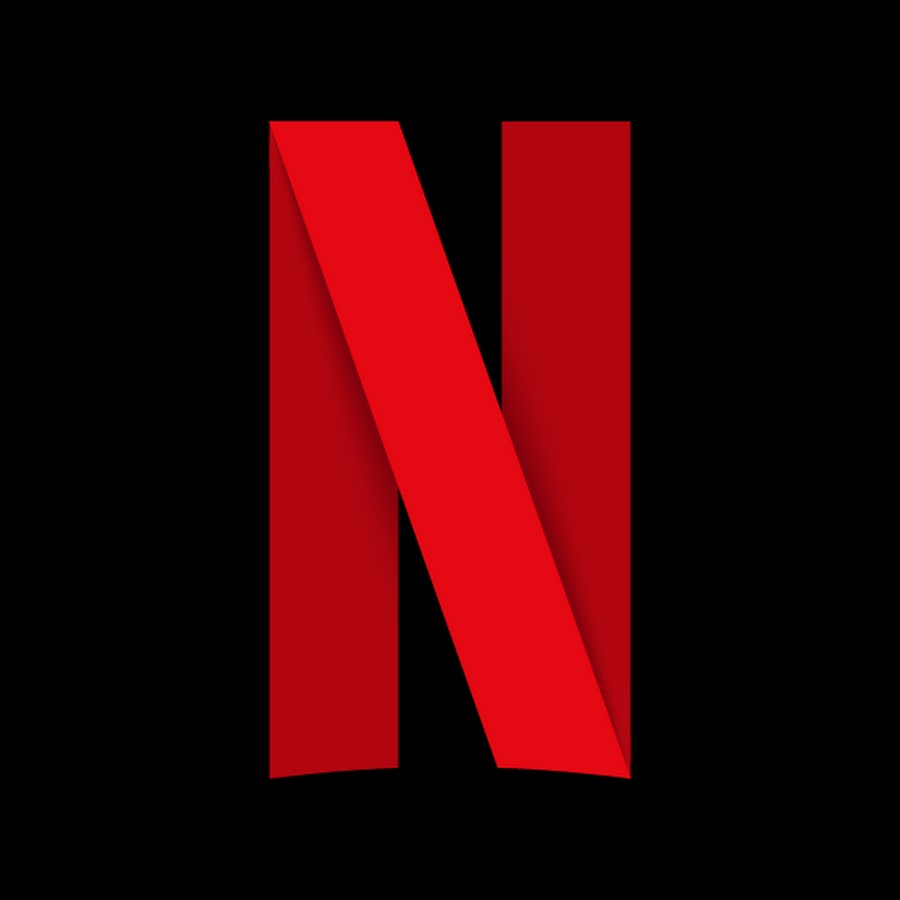
How do you continue to position yourself successfully in a changing market where competition is rapidly increasing? Netflix has become a household name in our society and culture, which is why we are looking at the positioning of the streaming service. It started as an online DVD rental company in 1997 and has since become the leading online streaming platform with over 200 million subscribers. We are examining how Netflix has built its brand and successfully positioned itself in a highly competitive and rapidly changing market.
 Who doesn’t know Netflix? The streaming service is no longer a newcomer, has established a strong position and is even considered a cool brand. The streaming service became well-known thanks to large original productions such as House of Cards, Stranger Things, Squid Game, Bridgerton and Lupin.
Who doesn’t know Netflix? The streaming service is no longer a newcomer, has established a strong position and is even considered a cool brand. The streaming service became well-known thanks to large original productions such as House of Cards, Stranger Things, Squid Game, Bridgerton and Lupin.
The Netflix brand is so strong that:
- ‘Netflixing’ has become a verb,
- ‘Netflix and chill’ has become a saying for several generations,
- Ben & Jerry’s now sells Netflix & Chilll’d
- for many people, “tu-dum” is a sound that is forever associated with Netflix.
The opening jingle is even so characteristic of the brand that Netflix recently organized a unique online party for fans: Tudum. During this online party, stars from the biggest Netflix hits gave a preview of the latest seasons. We, and many others, think that Netflix is a cool brand, and we are happy to explain why, which of course has a lot to do with positioning and marketing expressions.
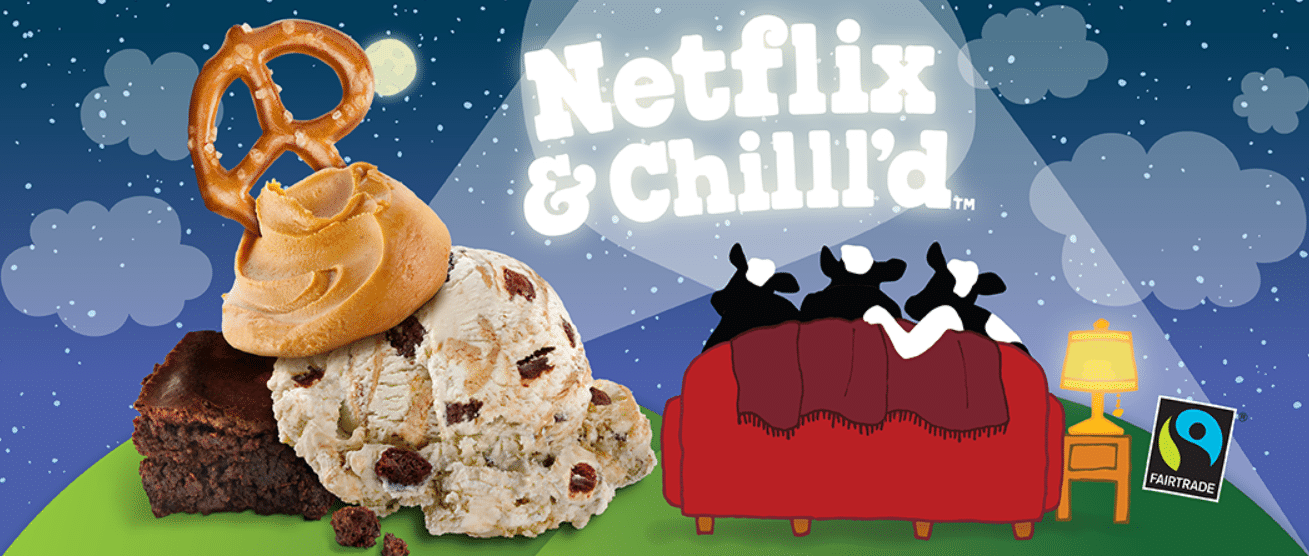
Netflix & Chilll’d, the Ben & Jerry’s flavor specially developed for the perfect night of Netflixing.
Was Netflix always an innovative concept?
Was Netflix always an innovative concept? Placing online DVD rental in the right context of its time, the answer is probably yes. But even when we delve deeper into its history, we quickly come across innovative concepts. Let’s go back to the year 2000: the year The Sims, Windows 2000, and the Worldonline stock were introduced. It was the year Netflix drastically changed its business model to a subscription-based service. Customers could no longer rent one DVD, but had to subscribe to Netflix, which allowed them to rent DVDs unlimitedly for a month. In 2021, subscriptions for services and products are commonplace, but twenty years ago, a subscription was a groundbreaking concept.
Thanks to this groundbreaking concept and the rapidly growing popularity of DVDs, Netflix grew quickly. In 2000, the company had 300,000 subscribers and $57 million in debt. But the tide turned quickly for DVDs, partly due to the arrival of streaming platforms and video-on-demand services. The first streaming platform, YouTube, was launched in 2005, followed by Amazon Prime (2006), Hulu (2007), and Netflix (2007). Thus, in both 2000 and 2007, Netflix made significant, innovative changes to its concept. Today, Netflix is the world’s largest streaming platform.
Positioning in a rapidly changing market
In the past twenty years, the way we watch movies and series has changed completely. How do you deal with rapidly changing demand as a brand? Netflix has been able to use these changes to its advantage, resulting in 203.6 million subscribers and $2.7 billion in profit in 2020. In this article, we answer the question: how has Netflix successfully positioned itself in a highly competitive and rapidly changing market?
Mission and vision Netflix
Netflix has a very clear vision for entertainment: streaming will replace linear television. People love television and movies, but not the experience of linear TV viewing because they are limited to a specific offering with a specific viewing moment that they can’t see everywhere. Streaming, on the other hand, offers a more personalized offering and is available wherever and whenever the viewer wants. Streaming services make it possible to watch TV and movies on demand and to binge-watch them. We can say that Netflix’s vision seamlessly aligns with the changing viewing behavior of their target audience.
Netflix has formulated the following mission:
At Netflix, we want to entertain the world. Whatever your taste, and no matter where you live, we give you access to the best-in-class TV shows, movies, and documentaries. Our members control what they want to watch, when they want it, with no ads, in one simple subscription.
Netflix: a “focus passion brand”
The goal of Netflix is to entertain its users wherever and whenever they want. To achieve this, the company has two core values:
- Content people love
- Focus passion brand
Content people love
Content is at the core of Netflix and is largely determined by the customer. This includes continuously improving the platform based on data, offering the right content at the right time based on personal preferences, creating new series and movies, and personalizing the promotion of new content.
Focus passion brand
Netflix calls itself a “focus passion brand”. A Netflix subscription is simple: for a fixed monthly fee, you can watch unlimited series and movies online, without ads, wherever and whenever you want. In addition, it is easy to cancel on a monthly basis. Netflix offers its customers the freedom, flexibility, and pleasure of “binging” whenever they want.
In addition, the platform has one specific focus: entertainment in the form of television and film. This means that subscribers will not find sports, news, music, or user-generated content on the platform. For a long time, games were also not an option, but Netflix has changed its stance on this. In late 2021, Netflix announced that it will soon offer games based on its most popular series and movies on the platform. With this change, Netflix hopes to reach younger generations, as CEO Reed Hastings has previously stated that Netflix is increasingly losing younger users to games such as Fortnite.
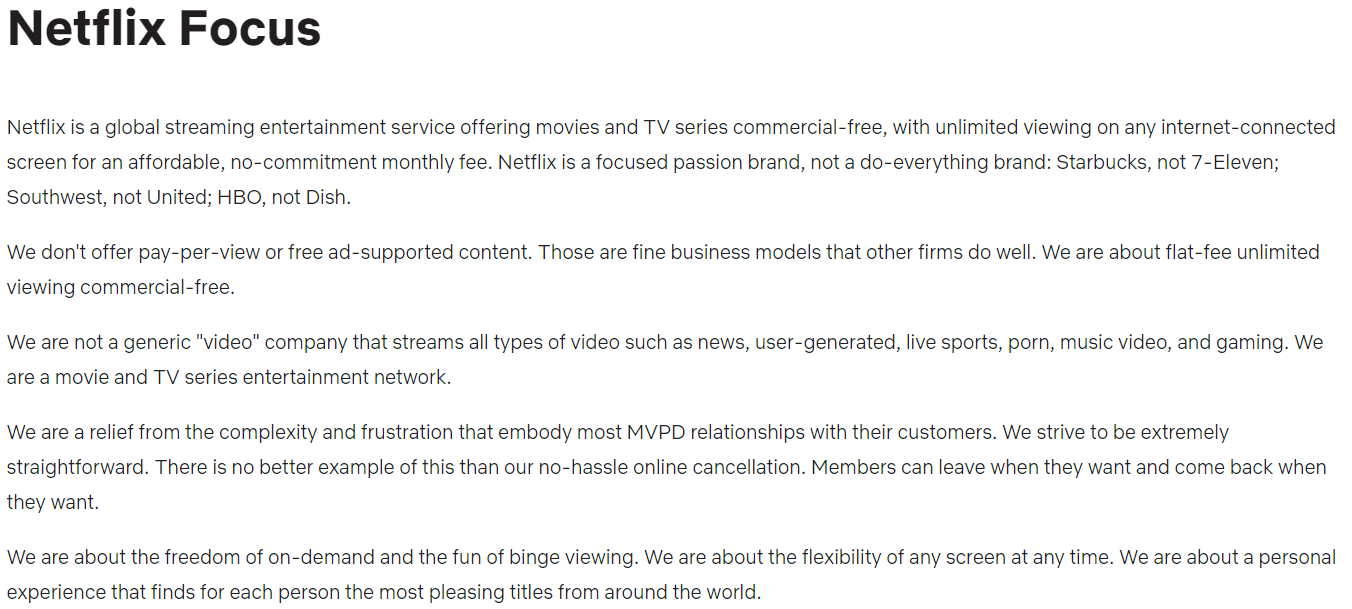
Netflix’s focus is on providing its users with the freedom, flexibility, and pleasure of binge-watching
Netflix brandarchetype: Jester
Netflix is convinced that they are improving the entertainment by offering movies and series. For over twenty years, they have been challenging the status quo. First, they challenged physical video stores by offering a DVD subscription service. Today, Netflix is challenging traditional TV viewing and commercials with its streaming platform.
This rebellious attitude is accompanied by a passion for content and humor. Humor is highly valued in Netflix’s communication strategy. From social media posts and online engagement with their audience to announcing new content, it has to be teasing, often funny, and frequently poke fun at a situation. Therefore, we can attribute the Jester brand archetype to Netflix. Like the Jester, Netflix is playful, cheerful, and critical. Fun and humor are at the forefront, but there is certainly a serious vision behind it.
For example, consider the launch of Narcos Mexico in Thailand, a heavily censored country where the often-naked, violent scenes involving alcohol, drugs, sex, and crime could not be promoted. What did Netflix do? They made fun of the Thai censorship. They released a modified trailer, where the forbidden parts were not visible but could be inferred, and supported this campaign with billboards that directly addressed the censorship and announced when the uncensored version of the show would premiere on Netflix. It was the ultimate tease and criticism of the Thai authorities.
It’s no surprise that the brand announced its Comedy branch under the slogan “Netflix is a joke,” with unique specials featuring world-famous comedians.
Social media and content strategy supports positioning
Essential to the success of Netflix is how they use social media. Of course, new series and films are announced on various social platforms, but by using these platforms as a communication tool with fans, it fits perfectly with their brand. The content and communication is full of humor and is often a dialogue with fans, which generates a lot of engagement.
Engagement is increasingly the leading factor in organic visibility on social media platforms, and Netflix knows how to make optimal use of it. Netflix is much larger on social media than competitors such as Amazon Prime, Disney+, HBO Max and Hulu. The result is a very large fan base that you can easily introduce to the latest Netflix offerings.
For example, the campaign for the second season of Narcos was inspired by the remarkable online reactions from fans. The first season was extremely popular and was often mentioned on Twitter as the way to learn Spanish. And so, Netflix launched “Spanish lessons with Narcos” prior to the second season. The campaign was an immediate hit and generated a lot of organic visibility for Narcos and the Netflix brand.
But, as befits a Jester, Netflix also knows how to offer a fitting message to its audience on more serious topics. For example, the second season of the popular series 13 Reasons Why was introduced with a campaign focused on awareness and prevention of youth suicide, called “13 Reasons Why Not.”
Netflix positions itself as the platform for entertainment
A positioning focused on entertainment with a significant role for communication through social media may seem quite logical and not very innovative for an online streaming platform. But it is. To support that judgment, we compared Netflix with its main competitors.
Hulu
Hulu’s mission is “to empower everyone to discover, share and celebrate the stories that connect us.” In Hulu’s vision, creating new and familiar experiences is central, challenging makers to push the boundaries of storytelling and lead the future of streaming. For example, during the Covid-19 pandemic, Hulu launched a unique concept called Hulu Watch Party, which allows subscribers to stream Hulu content together from different locations, with synchronized streams and private chat.
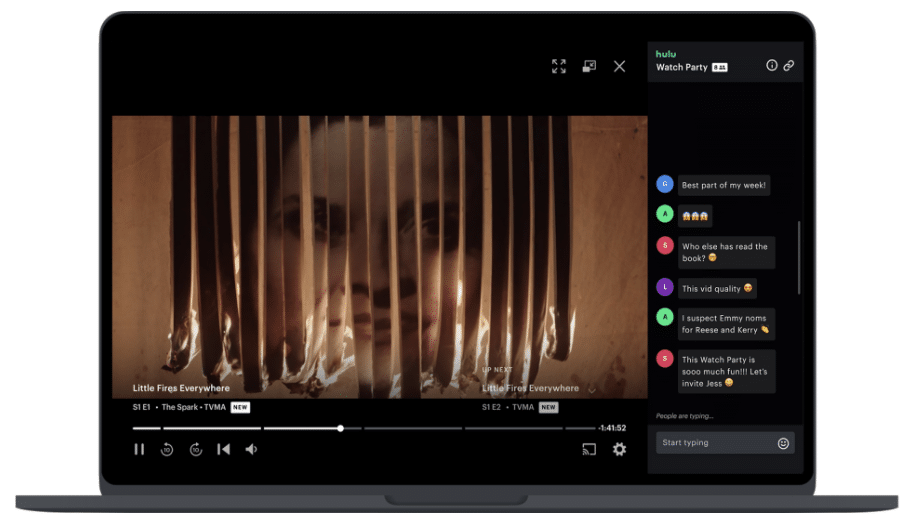
Hulu Watch Party: stream together
Hulu’s offerings include its own documentaries, series, and films, supplemented by series and films from other producers. This content is offered at a reduced rate with ads, or for a higher rate, ad-free. A major contrast with Netflix is that binge-watching is almost impossible on Hulu because episodes are released one by one. Hulu is now 100 percent owned by The Walt Disney Company and collaborates with Disney+ and ESPN to offer customers a comprehensive package of entertainment, such as live sports events and children’s movies.
Amazon Prime
Amazon Prime is part of Amazon, the company that strives “to be Earth’s most customer-centric company, where customers can find and discover anything they might want to buy online.” The biggest difference between Amazon and Netflix is therefore the availability of content. Amazon wants to be able to serve its customers at all times, which is why it chooses a hybrid content model, in which some of the content is released all at once on the platform, but some, such as films, can be rented for a premium price before their release date. This allows Amazon subscribers to enjoy the latest films soon after their theatrical release.
Like Netflix, Amazon’s offerings include original and acquired productions. A big difference is that you can subscribe to Amazon Prime Video, but you can also choose an Amazon Prime subscription that includes access to e-books, music, and free shipping for everything you buy on Amazon.
HBO Max
The biggest difference between HBO Max and the other platforms is that HBO Max is part of one of the largest television networks in the United States, HBO. This means that the platform has direct exclusive rights to many successful series such as Game of Thrones, Chernobyl, and The Wire. In 2021, HBO Max also partnered to release all Warner Bros. and DC Movies directly after their theatrical release.
Compared to the other streaming platforms, HBO Max may be a bit of an odd one out in terms of its mission and vision. Its big brother HBO has formulated the following: “At the heart of HBO is our passion for making a difference, and every day we are using our platform to educate, inspire thoughtful action, and help make the world a better place.” How HBO Max fits into this is not yet entirely clear to us, but perhaps this will become clearer when HBO Max becomes available in the Netherlands from 2022 onwards.
What does Netflix’s positioning bring to the table?
Netflix is by far the largest online streaming service worldwide in terms of number of subscribers. In addition to the three other streaming services discussed in this article, there are countless other global and local streaming services, but due to its strong positioning, this is not a threat for Netflix. This has led to Netflix becoming a household name, inextricably linked with streaming services and entertainment.
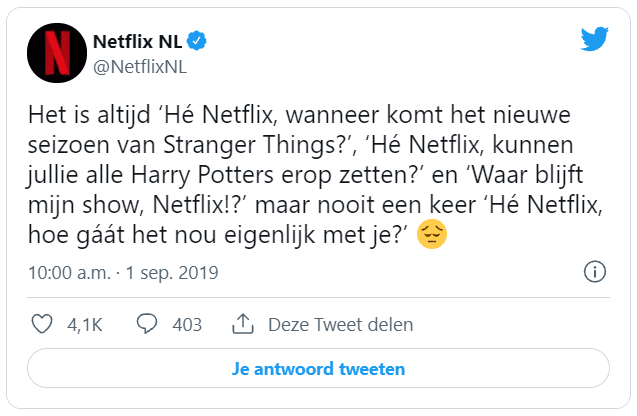 Compared to its competitors, it has not only led to a very clear and strong position, but also to a unique online presence that we do not see with any of the other platforms. None of its competitors are praised for cool campaigns or how they communicate with their subscribers, not even Amazon, where the customer is at the center.
Compared to its competitors, it has not only led to a very clear and strong position, but also to a unique online presence that we do not see with any of the other platforms. None of its competitors are praised for cool campaigns or how they communicate with their subscribers, not even Amazon, where the customer is at the center.
In addition to brand value and a large number of subscribers, another valuable result of its high-quality positioning is a certain immunity among the target audience. As a result, the Netflix brand experiences little damage from price increases and commotion surrounding celebrities associated with Netflix, especially in a time when “cancel culture” quickly makes victims, this is a very valuable result.
Do you want to learn more about positioning and how to get started with it yourself? Visit our Positioning page and find in-depth articles as well as dozens of examples and models for any possible positioning challenge.